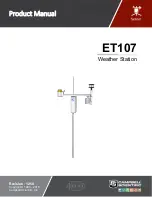
ET107 Weather Station
6
User supplies valve box at base of station and weatherproof
enclosure for transformer (FIGURE
).
The AC power supply option at one time included a step-down
transformer instead of the power supply. Appendix
(p. F-1)
, provides information about using
the step-down transformer.
Phone Modem
Phone modem at the central computer.
Dedicated single twisted pair with shield phone line to the weather station
valve/junction box (FIGURE
Short-Haul Modem
Direct burial cable with a minimum of two-twisted pairs with shield (minimum
five conductors total) to travel from the weather station to the central computer
junction box. Direct burial armored cable may be required for rocky soils or
rodents (Anixter pn F-02P22BPN (phone 847-677-2600)) or equivalent type
cable (FIGURE
Radio
Antenna for the ET107 station (Yagi antenna recommended). PS24 Power
Supply and mounting kit with hangar if not using ac power (Appendix
24 Ah Power Supply and 10 x 12 inch Enclosure
(p. C-1)
).
5. Installation
5.1 Siting and Exposure
Do not install near power lines. If any part of the pole
comes in contact with power lines, you could be
KILLED. Contact local utilities for the location of buried
utility lines before digging or driving grounding rods.
Selecting an appropriate site for the weather station is critical to obtain accurate
meteorological data. In general, the site should be representative of the general
area of interest, and away from the influence of obstructions such as buildings
and trees.
The weather station should not be located where sprinkler irrigation water will
strike sensors or instrument enclosure.
Some general guidelines for site selection are listed below, which were
condensed from EPA (1988)
1
, WMO (1983)
2
, and AASC (1985)
3
publications.
5.1.1 Wind Speed and Direction
Wind sensors should be located over open, level terrain, and at a distance of at
least ten times (EPA) the height of any nearby building, tree, or other
obstruction (FIGURE
NOTE
NOTE
DANGER
















































